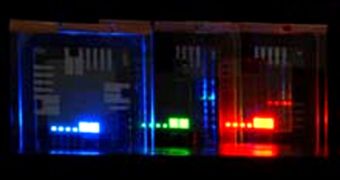Organic light-emitting diodes (OLED) have for some time been touted as the next big thing for the display industry, but thus far they have failed to meet expectations. Now, a company proposes moving on, and shifting research focus from OLED to quantum dot-based displays.
One of the main things OLED have going for them is the fact that they are bright, and also very energy-efficient. Their main disadvantage, on the other hand, is that they cannot be readily mass-produced.
As such, the world has only seen them being introduced inside small devices, such as for example mobile phones and related devices. Producing them in large-enough numbers to create computer and TV displays is still impractical.
Undoubtedly, given enough time, the field will evolve, and develop technologies for mass-producing OLED at affordable prices. But a Massachusetts Institute of Technology (MIT) spinoff company called QD Vision Inc. is proposing another solution for efficient lighting.
Experts here say that developing quantum dot-based display technologies is the way to the future. These displays are even brighter and more energy efficient than OLED, but, most importantly, easy to produce at an industrial scale.
The company has already formed a partnership with a major manufacturer LG Display, for creating a new generation of displays that would use quantum-dot light-emitting diodes (QLED) for pixels.
At the same time, Belgium-based chemical company Solvay was contracted to build the platforms needed for the mass printing of QLED, Technology Review reports.
One of the most interesting things about QD is that they can shine in spectrally pure colors. They are also capable of both photoluminescence (shining when exposed to light) and electroluminescence (shining when exposed to electrical currents)
QD electroluminescence is “something we've been working on a very long time, and now it's getting to this point of commercial traction,” explains the chief technology officer (CTO) of QD Vision, Seth Coe-Sullivan.
“Small OLED displays are getting very good market traction, but there are still some unresolved challenges with OLED, and we see QLED as a way to solve them,” the company official adds.
“If they can make this electroluminescence technology work, then we think that's a good thing for the industry,” explains the president of Silicon Valley-based company Nanosys, Jason Hartlove. The firm is also involved in developing QD-based technologies.
“My personal view, which goes against what some folks in the industry are betting on, is that OLED displays will never really gain full traction. Then there will be a new tech that will emerge, and we hope that'll be emissive quantum dots,” he concludes.

 14 DAY TRIAL //
14 DAY TRIAL //